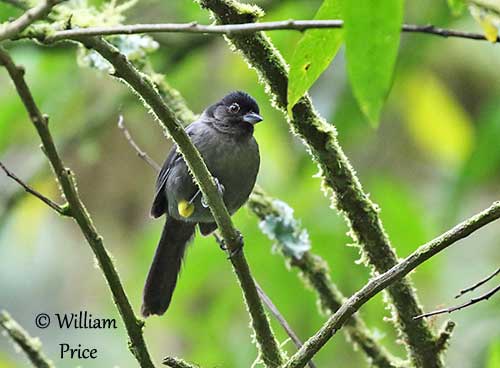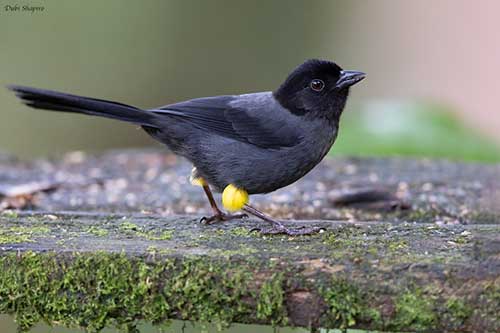
PROTECTION / THREATS / STATUS:
The Yellow-thighed Finch is a restricted-range species, described as “common” to “fairly common” especially in the highlands within the range.
The species is more or less affected by forest loss and the population is suspected to be stable.
The Yellow-thighed Finch is not globally threatened, and currently evaluated as Least Concern.
Fr: Tohi à cuisses jaunes
Ang: Yellow-thighed Finch or Yellow-thighed Brushfinch
All: Gelbschenkel-Buschammer
Esp: Cerquero Musliamarillo
Ita: Fringuello zampegialle
Nd: Geeldijstruikgors
Sd: gullårad snårsparv
Photographers:
Didier Buysse
Vision d’Oiseaux
Ken Havard
My Bird Gallery & Flickr gallery 1 & Flickr gallery 2
William Price
PBase-tereksandpiper & Flickr William Price
Dubi Shapiro
Dubi Shapiro Photo Galleries
Text by Nicole Bouglouan
Sources:
HANDBOOK OF THE BIRDS OF THE WORLD Vol 16 by Josep del Hoyo- Andrew Elliot-David Christie – Lynx Edicions – ISBN: 9788496553781
THE AVIANWEB - Beauty of Birds (Sibylle Faye)
Wikipedia, la enciclopedia libre
Wikipedia - New World sparrows
CREAGUS@Monterey Bay (Don Roberson)
Yellow-thighed Finch or Yellow-thighed Brushfinch
Pselliophorus tibialis
Passeriformes Order – Passerellidae Family
INTRODUCTION:
The Yellow-thighed Finch is endemic to the highlands of Costa Rica and W Panama where it frequents wet montane forests, scrubby pastures and bushy clearings, up to the treeline. Outside of breeding season, it usually descends to lower elevations on the Caribbean slopes.
This species is known as a frugivorous, nectarivorous and insect-eater, and it forages from the ground to the treetops. The nest is a bulky, cup-shaped structure well-hidden in the understorey, from 50 centimetres to 4,5 metres above the ground. They are gregarious and often join mixed-species flocks.
The Yellow-thighed Finch is a restricted-range species described as “fairly common” and not globally threatened.

DESCRIPTION OF THE BIRD:
Biometrics:
Length: 17-18,5 cm
Weight: 27-34 g
The Yellow-thighed Finch is a dark finch with a long tail (7,8/8,5 cm) and conspicuous bright yellow thighs giving the bird its name.
The adult male has slate-grey upperparts with darker, mostly blackish wings and tail.
The underparts are slate-grey too, but sometimes with olive-green wash on the breast. The thigs are bright yellow and contrast strongly with the dark body plumage.
The head is deep black, except for the slate-grey rear ear-coverts to lower throat. However, the slate-grey colour may sometimes extend on the entire ear-coverts, cheek, chin and throat.
Some individuals may show a few whitish feathers, especially on upper eyelid and side of forehead, and white spots at the bend of the wing.
The pointed bill is black. The eyes are rusty brown. Legs and feet are dusky.
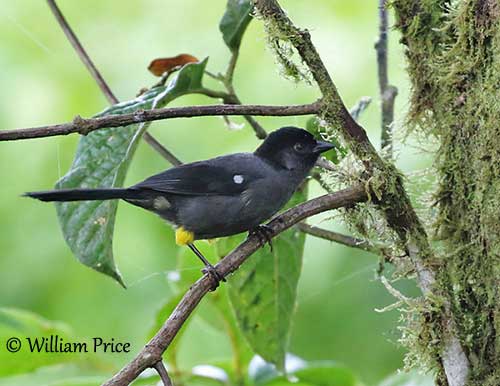
Male and female have similar plumage, but she has slightly longer wings and tail.
The juvenile resembles adult but the upperparts are duller whereas the underparts are tinged brownish. The thighs are dark grey.
RANGE:
The Yellow-thighed Finch is found in the mountains of Costa Rica (S from Cordillera de Tilarán) and extreme SW Panama (W Chiriquí).
However, following the heavy deforestation of Central plateau of Costa Rica, the species is no longer present in this area.
HABITAT:
The Yellow-thighed Finch frequents the primary and degraded humid mountain forests where it is relatively common in the understorey. It is also found in second growth, ravines with bamboos, adjacent shady pastures and bushy clearings.
The species occurs from 1,200 to 1,700 metres of elevation, depending on the season.
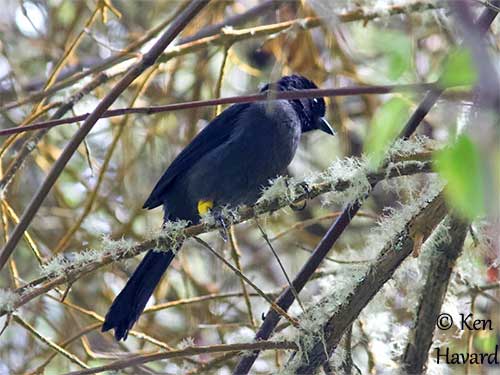
CALLS AND SONGS: SOUNDS BY XENO-CANTO
The Yellow-thighed Finch’s call is a metallic “tchuk” and we can also hear cheeky “quick” calls and an accelerated, hard chatter.
The song consists of bubbly, metallic, tinkling, high dry notes rapidly repeated. The male gives this song all year round and during the day. Both mates produce this song to greet each other when they reunite. This song may last up to 20 seconds.
But this species produces another song during the breeding season, and the male sings at dawn. This song is short and more complex and repeated up to 10 times per minute. It is described as “tee tiddy dee dee wink wink” or “pitty me sweet sweet” or “t’chip-didichichi”.
The function of this song is poorly known, but we can suggest that it is used to advertise the territory every day at dawn.
BEHAVIOUR IN THE WILD:
The Yellow-thighed Finch feeds on a variety of insects and spiders caught within the vegetation and off the ground. But its diet also includes berries (Melastomataceae) in W Panama, fruits (Solanaeceae) and seeds of some of these plants. The berries may be worked inside the bill, but the seeds are not always ingested.
This species also takes nectar from tubular flowers by pinching the corollas of Jacobinia aurea and Salvia nervata to get the nectar.
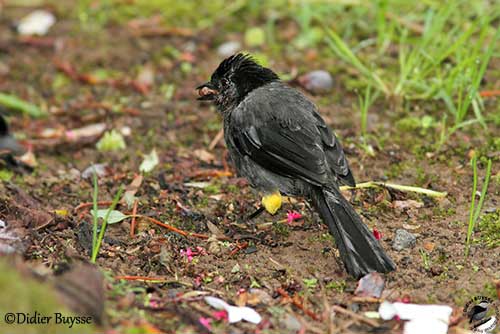
The Yellow-thighed Finch forages both on and close to the ground, but also higher, up to treetops. On the ground, it searches among the leaf litter. It also plucks small protein capsules from the hairy bases of petioles of Cecropia leaves. It may sometimes follow army ants (Formicidae).
It is usually found in pairs and family groups, but this species is gregarious and often joins mixed-species flocks.
It is active and noisy, and frequently flicks the tail while foraging by hopping on the ground and performing bill-sweeping.
The behaviour of the Yellow-thighed Finch during the breeding season is very poorly known. Both mates are observed singing together at nest. We can also suggest that the bright yellow thighs are exposed and enhanced during the displays.
The nest is an open cup well-hidden in the understorey. The female does most of the nesting duties.
The Yellow-thighed Finch is sedentary. It may perform some altitudinal movements, descending to lower elevations after breeding.
This species does not perform long-distance flights.
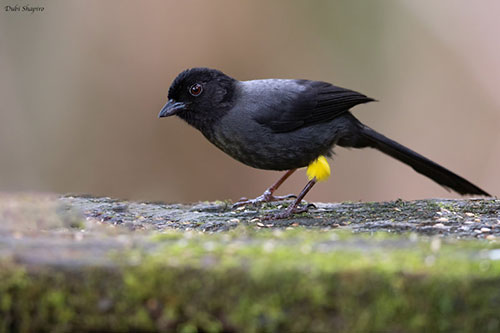
REPRODUCTION OF THIS SPECIES:
The breeding season takes place from March to May in Costa Rica.
The nest of the Yellow-thighed Finch is an open cup built by the female. The bulky structure is made of dried bamboo leaves and dry grass. The cup is lined with fine plant fibres or bamboo leaves. It is placed between 50 centimetres and 4,5 metres above the ground, in coarse grasses, bamboo or densely foliaged tree, often in ravines covered with vegetation, especially bamboos.
The female lays 2 white to pale blue eggs with dark markings. She incubates alone during 12-14 days, and the young fledge 12 days after hatching.
The female performs wing-raising, trying to feign an injury if an intruder approaches the nest. The role of the male during this period appears to be minimal, except for singing.
